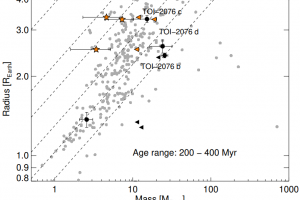Sub-neptunian planets and photoevaporation for BD+40 2790. The study: “The GAPS Programme at TNG. LIX: A characterisation study of the ∼300 Myr old multi-planetary system orbiting the star BD+40 2790 (TOI-2076)” of M. Damasso (INAF – OATo) appeared on A&A

The study of exoplanetary systems of stars with an age of a few hundred million years can teach us a great deal about the early and crucial evolutionary phases of planetary systems. Processes such as planetary migration, which causes planets to modify their distance from the central star, the circularization of orbits, and planetary photoevaporation play a fundamental role in determining the final architectures of planetary systems. In particular, photoevaporation is triggered when the outer layers of a planet’s atmosphere are intensely irradiated by high-energy radiation (UV and X-rays) coming from the central star. The energy transferred to the atmosphere causes the gas in the outermost layers to disperse, thus inducing a mass loss rate, which can be significant, from the planet.
The study of young exoplanetary systems is complicated by the intense magnetic activity typical of young stars, which can produce signals that may hide or sometimes even mimic the signals caused by the presence of exoplanets around the stars. To minimize the impact of magnetic activity, long observation campaigns are necessary for each individual star candidate hosting planets, using spectrographs with high spectral resolution. This is now possible thanks to international projects and observation campaigns like the GAPS (Global Architecture of Planetary Systems) project, which involves significant participation from astronomers of the Italian National Institute for Astrophysics (INAF).
The team led by astrophysicist M. Damasso (INAF – Astrophysical Observatory of Turin) studied the exoplanetary system orbiting the K-type star BD+402790 (also known as TOI-2076), with an age of about 300 million years, through the analysis of a series of 300 spectroscopic observations taken with the HARPS-N spectrograph, mounted on the Telescopio Nazionale Galileo. In 2021, thanks to observations from NASA’s TESS satellite, a true exoplanet hunter, three exoplanets were identified around this star in a very compact system, with orbital periods of 10 (BD+402790 b), 21 (c), and 35 (d) days. Additionally, a 2023 study provided evidence supporting the presence of an extended atmosphere containing helium on planet b, observations which were subsequently questioned by another study published a few months later.
By applying a new technique aimed at reducing the impact of the stellar magnetic activity in an attempt to measure the mass of the planets, the team led by Damasso was able to establish upper limits on the masses of the BD+402790 planets: 11-12, 12-13.5, and 14-19 (with more probable values between 7 and 8) Earth masses for planets b, c, and d, respectively. Subsequently, the researchers produced an estimate of the rate at which the planets will lose mass due to the photoevaporation process over the next 10 billion years. The model predicts greater mass loss for planet c and then planet b, while the evolution of planet d radius will primarily depend on the normal gravitational contraction of the planet rather than the photoevaporation process. Over a period of 5 billion years, the planets will have a radius of 1.5-2 Earth radii (planet b), 2.5-3 or less than 2 Earth radii (planet c), and 2-3 Earth radii for planet d. The study is described in the article: “The GAPS Programme at TNG. LIX. A characterization study of the ∼300 Myr old multi-planetary system orbiting the star BD+40 2790 (TOI-2076)“, recently published in the journal Astronomy & Astrophysics. Among the co-authors are also the astronomers D. Locci, S. Benatti, A. Maggio, G. Micela, and R. Spinelli of INAF – Astronomical Observatory of Palermo.
The cover image (click here to view it fully) shows the mass-radius diagram. The values corresponding to the planets of BD+402790 are indicated, using different symbols depending on the method applied to estimate the planets masses.
Mario Giuseppe Guarcello
Follow MarioSpiegaCose on Instagram () , Facebook (), Youtube (), and X ()
Follow the Astronomical Observatory of Palermo on Facebok and on Instagram
Subscribe the Youtube channel of the Astronomical Observatory of Palermo
